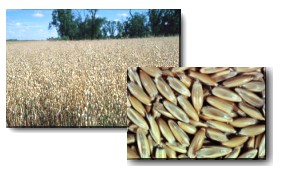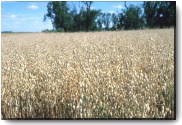Oat Production and Management
|
The unique climate in Manitoba makes it one of the most productive places in the world to grow oats. The long warm days characteristic of the Canadian prairies coupled with adequate moisture levels provides producers with ideal oat-growing conditions.
As well, Manitoba has the added benefit of its central location in the heart of North America, close to major processors in Canada and the United States, and its excellent service by road, air and rail. Together these factors result in high quality, easily accessible oats.
Field Selection
Select fields with good drainage, sandy loam to heavy clay soil textures. Avoid fields that had cereal crops in the previous year to reduce disease pressure and optimize yields.
Variety Information
Performance Testing
Variety performance, acreage, seeding date and crop rotation affects on yield.
- Manitoba Management Plus Program by Manitoba Crop Insurance Corporation
Seeding Oats
Treatments
There are a limited number of seed treatments available. To prevent smut, seed should be treated with a fungicide. Seed treatment is recommended for hulless oats.
Dates
May 1 to June 10. Oats give best returns when sown early.
Rates
1.5 to 3 bu/acre to achieve a plant population of 18 - 23 plants/ft2.
Calculation of optimum seeding rates using plant population.
Circumstances requiring heavier rates of seeding are large seed size, low germination, late seeding, presence of wireworms, abundant moisture reserves, heavy textured soils, high soil fertility, deep seeding, low bushel weights and rough seed bed.
Hulless oats have a thin seed coat which is subject to cracking, resulting in lower germinations. It is important to know the level of germination in order to adjust the seeding rate. The seeding rate of hulless oats is 48 - 62 lb/acre or to achieve a plant population of 18-23 plants/ft2.
Seeding Depth
1.5 to 3 inches. Seed should be placed only deep enough to reach moisture. Seed placed deeper than three inches may result in reduced emergence and reduced yields.
Fertilizer Requirements for Oats
For specific recommendations, have your soil tested. If soil analyses are not available, a general recommendation is as follows:
| Nitrogen (N): | Apply 0-30 lb/acre N following fallow or legume breaking, 30-55 lb/acre following grass and grass-legume breaking and 55-90 lb/acre N following stubble. The primary nitrogen deficiency symptom is leaf yellowing starting with the older leaves. |
| Phosphate (P2O5): | Apply phosphate at 30-40 lb/acre. The primary phosphorus deficiency symptom is leaf purpling/browning starting at the tips of older leaves on the seedling. |
| Potassium (K2O): | On sandy-textured or organic soils apply potassium at 15-30 lb/acre potash (K2O) in a sideband or 30-60 lb/ac broadcast. Where required, potassium should be placed with the seed. Deficiency symptoms are difficult to detect but include short internodes and weak stems. |
| Sulphur (S): | Apply sulphate sulphur at 15 lb/acre on well-drained soils. Sulphur deficiency may occur in many soils and in any area of the province. A soil test is recommended to establish the available sulphur status of fields. |
Weed Control
Weeds can reduce yields and the quality of the crop. Weed seeds that cannot be cleaned out and are considered foreign matter causing downgrading are: other cereal crops, grains other than cereal crops, wild oats. There are no herbicides available for controlling these weeds in oats. Use proper crop rotations and cultural strategies to ensure oats are planted on fields free of these weeds.
Insects
Aphids, armyworms, cutworms, leafhoppers, grass thrips, wireworm, grasshoppers and the wheat stem maggot can damage oats.
How to obtain printed copies of the Field Scouting Guide and Guide to Crop Protection.
Diseases Affecting Oats
Earlier seeding and heavier seed rates will reduce damage by barley yellow dwarf virus.; The primary symptom of BYD infection in oats is red leaf.
Seed treatments are available for the control of seedling blight and smut diseases carried on the seed. Most older varieties have only poor resistance to crown rust (leaf rust) and serious yield losses can occur especially to late planted oat crops. A fungicide is recommended for control of rust on these older varieties. Currently recommended oat varieties are resistant to oat stem rust.
Crop disease identification, scouting techniques, economic thresholds.
For information on varietal differences to disease susceptibility consult Seed Manitoba.
How to obtain printed copies of the Field Scouting Guide and Guide to Field Crop Protection.
Harvesting Oats
SwathingHighest yields are obtained by swathing when the kernel moisture content is about 35%. The greenest kernels at this stage have just changed from green to cream-coloured. To obtain highest milling grades, green hulls should not form part of the oat sample. |
 |
Combining
To obtain highest milling grades, dehulled kernels must be avoided. This may involve slower cylinder speed and wider concave clearances.
Hulless oats are vulnerable to damage. Thresher cylinder speed should be reduced to approximately 900 rpm and the concaves adjusted carefully to prevent damage.
Storage
Oats with a moisture level 12% or less will store properly. If moisture is above 12%, it should be dried and/or bin aerated to prevent heating and mould development.
These and other Manitoba Agriculture publications are available from your local office location.

